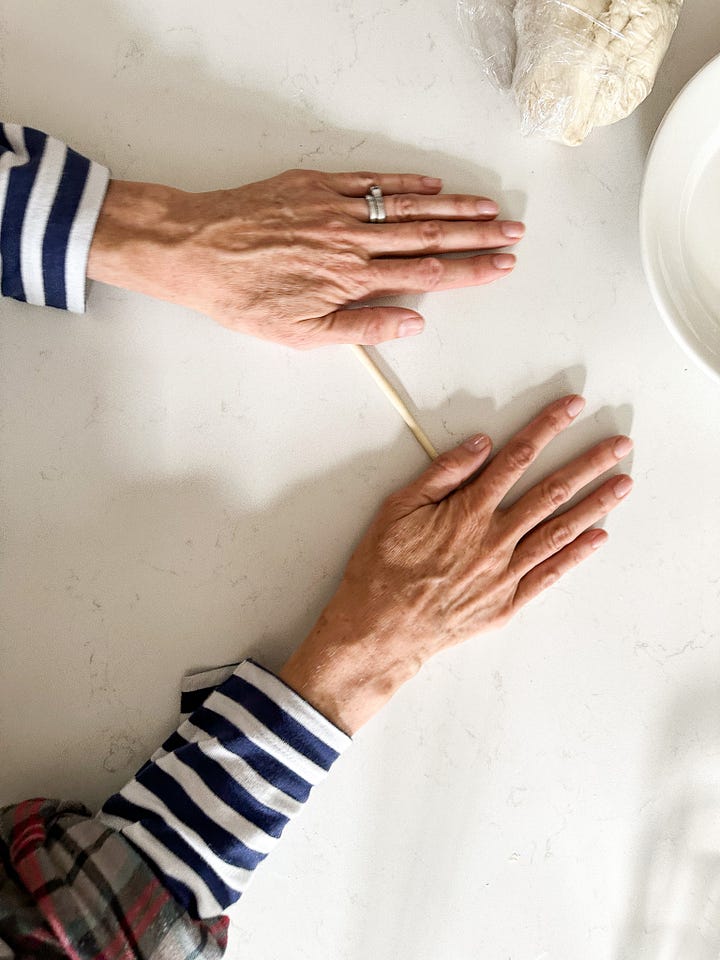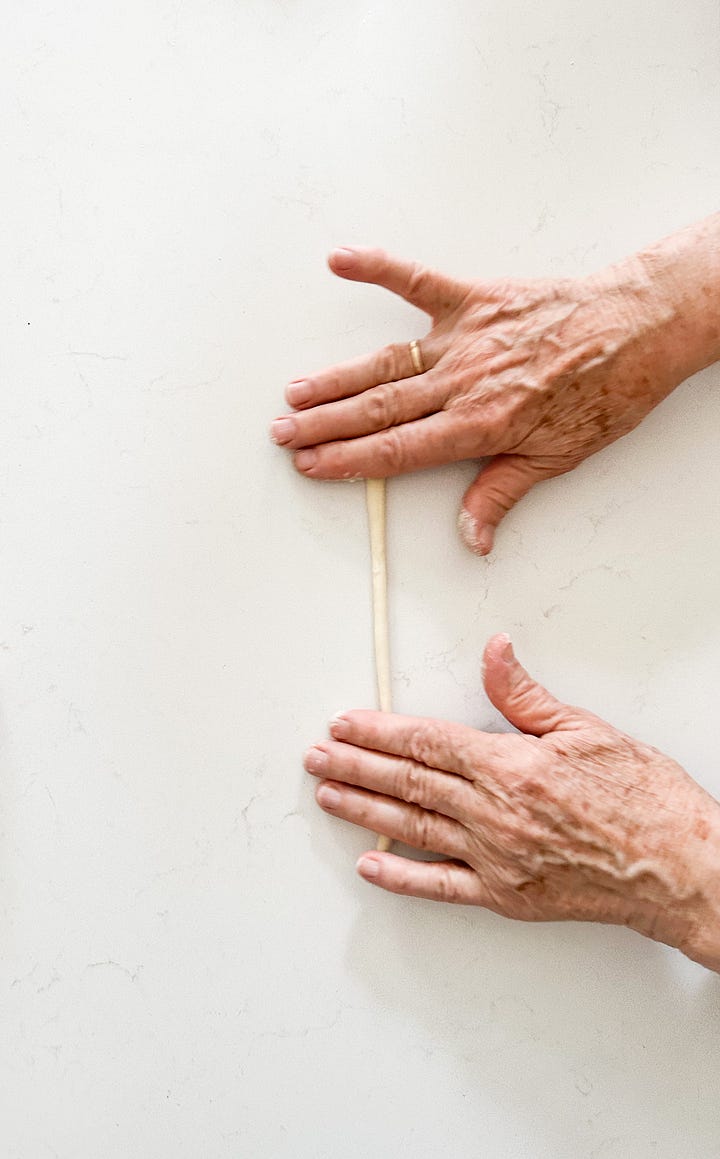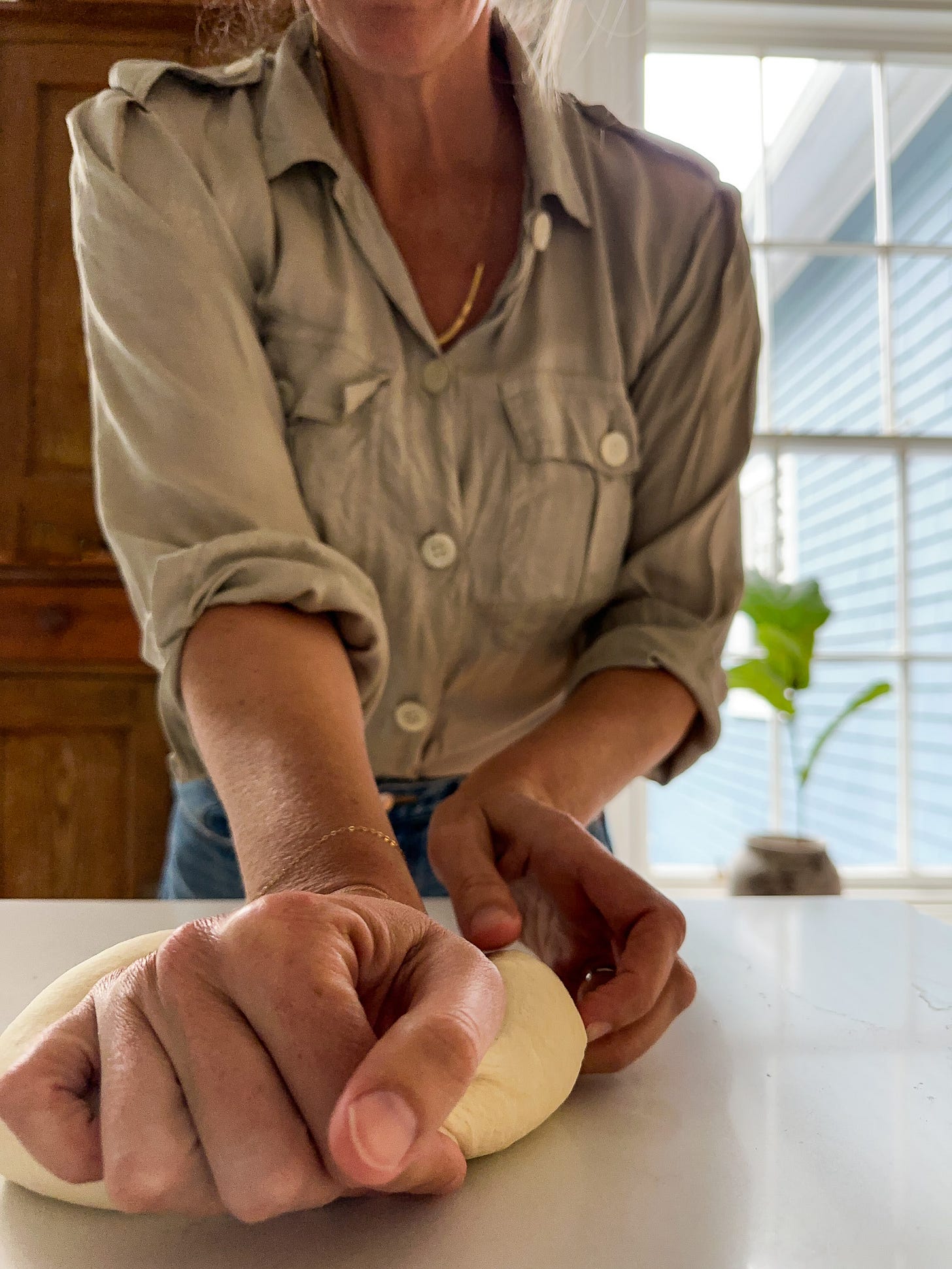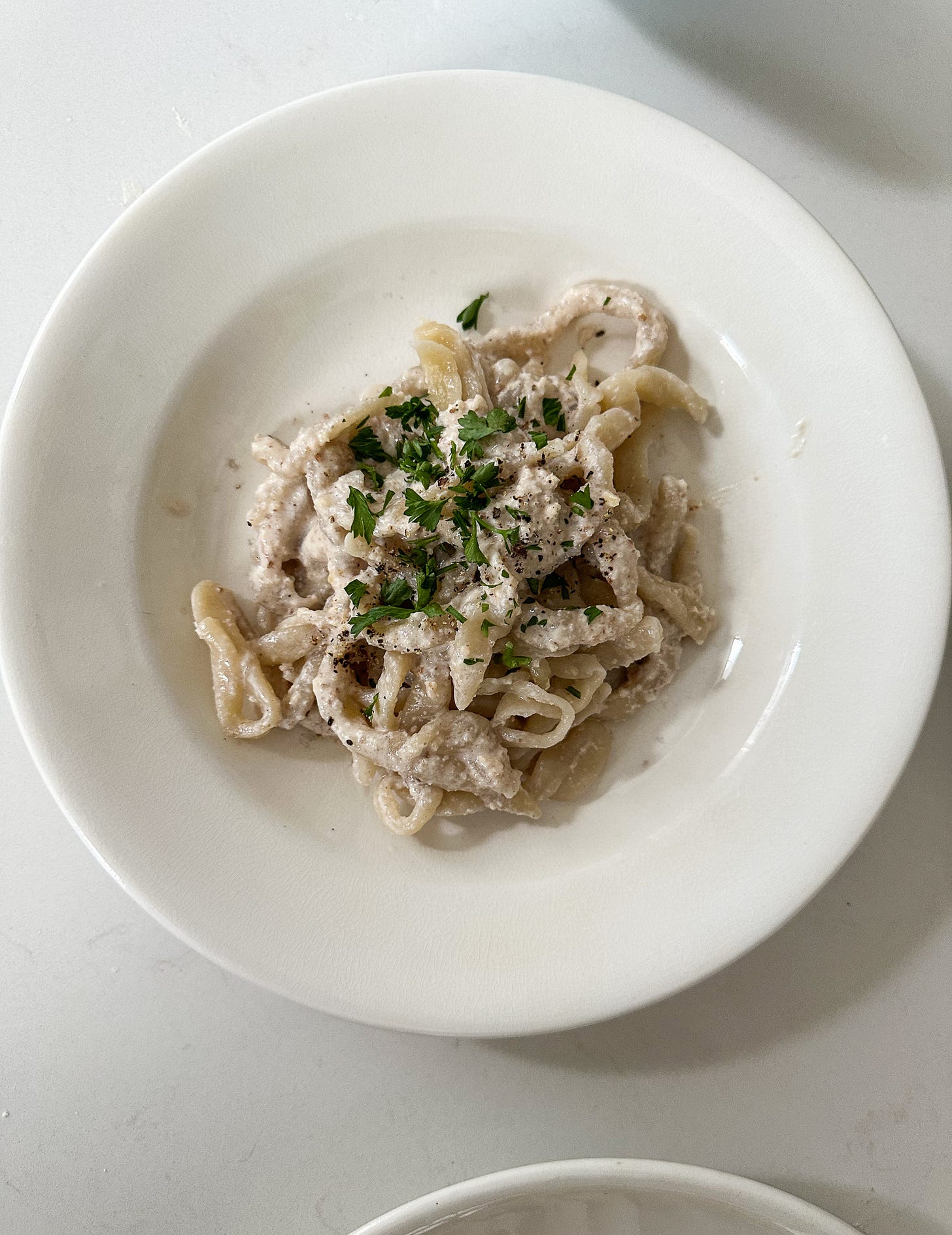I am wearing an oyster coloured top, the same tones as pasta with walnut sauce. It’s an old Jil Sander that I found at a second hand store several years ago. Crinkled silk with big, pearly buttons. It’s perfect for today - old enough to make a rustic hand-rolled pasta, and smart enough to sit down and eat it.
I learned to make this pasta while away in Italy with a group of friends. The chef had prepped our stations - a small bowl of 00 flour,1 a glass of water and a small bowl of finely ground semolina. No eggs, no tools, just those three things. He taught us to pour the water into the flour, a little at a time, and stir the mixture with our hands. When it came together, we tipped it onto a board and gave the dough a good knead. It was a golden moment - the Tuscan sun was setting in our faces, dropping slowly behind a rolling horizon spiked with cedars. We celebrated the twentieth anniversary of the movie Under the Tuscan Sun by watching it the night before, projected onto a stone wall. We crowded into a little room at our Tuscan hotel, ate popcorn and listened to the cicadas while a heartbroken Diane Lane hopped off her bus tour on a windy road in Cortona and began a new life in a crumbling villa in Tuscany. Vulture Magazine reported that the movie was a success because it hit ‘all four quadrants of escapist cinema: romance, real estate, Italian food and friendship.’ We were hitting the last two tenants hard on this trip. And it’s safe to say we all stopped to look at the listings in the windows of real estate offices as we sauntered through Cortona eating gelato. Under the Tuscan Sun was based on a memoir by the writer Frances Mayes. She still lives in Cortona. Heck one of us could be her neighbour one day.
So there we were, filled with love and sunshine, ready to turn that smooth ball of dough into pici, a Tuscan hand rolled spaghetti of sorts. The idea is to pinch off a piece of the dough and roll it on the counter with flat hands, gently pulling the dough outward as you roll until you have a long cord slightly thicker than spaghetti. An Italian woman named Paola was there to help us. She deftly rolled the pasta with ease until long cords appeared beneath her hands. Some of us were better than others. My sister Lee rolled her pasta quickly, tossed the strands in semolina then piled them together as directed. One woman picked up her strip of dough and stretched and pinched it into shape. Paola smiled but shook her head. Non autentico. I struggled the most. Cooking school and years in the kitchen doesn’t mean you can make pici. “Leggerment,” Paola said to me. Lightly. I’m sure she also said quickly. We would be eating this pasta for dinner. The sun had dropped behind the cedars by the time I had finished.
I’m trying pici again today at home in my kitchen. The sky is grey outside the window. The last of the hydrangeas bow their heads, saddened by fall. But it’s not quite sweater weather. I’m still in that shirt.
I’ve employed two helpers - Aunt Sandra and my basically Italian sister Lee. I made the dough and the sauce (the easy part) before they arrived, and while they roll the pasta, I DJ, slice lemons for water and send a few emails. I stop to help briefly, trying my best to lightly roll the dough into rustic spaghetti. I am leggero e lento - light and slow. I think about the years spent rolling play dough with my boys. I wish I had known this recipe when they were little. They could have made dinner.
My niece drops in to eat with us, so I divide the pasta between the four of us. It doesn’t look like a lot of food. But each bite is so toothsome, so flavourful, that I take it light and slow. We light a candle and eat until we’re full.


Walnut Sauce
It’s traditional, I’ve learned, to serve pici with a bread based sauce. That night in Italy we ate our pici with garlicky toasted breadcrumbs tossed with olive oil, parsley and lemon zest. To properly fuel the workers at my house (who rolled pasta for 56 minutes straight) I made salsa di noci, walnut sauce. The recipe is simple: Soak a slice of bread in ¾ cup milk (I used a seeded sourdough, but white bread is traditional). Put 150g (1 ½ cups) walnuts in a food processor along with a clove or two of garlic, 50g (1 cup) grated parmesan, the bread and the milk. Blend until smooth, adding a few tablespoons of olive oil as the motor runs. Season with sea salt and black pepper and set aside until ready to serve. I chopped parsley and grated extra cheese to top the pasta.
Pici
Don’t let my experience of pathetic rolling keep you from making Pici. We followed this recipe, with a few caveats, as mentioned above:
Prep/ rolling time is longer than 20 minutes. I’d say it’s as long as it takes to enjoy golden hour and watch the sun set slowly over the rolling hills of Tuscany.
There will be a moment when you think your efforts will not be enough for four people. There will be enough. Pici is meant to sustain Tuscan peasants. It's hearty.
This recipe calls for olive oil. We didn’t use oil while making pici in Tuscany and it worked just fine. It’s optional.
To serve pici with walnut sauce, boil the pasta in a big pot of salted water. Ladle a cup of pasta water into a small bowl and set aside. Cook the pasta (this doesn’t take long), drain and return to the pot. Add walnut sauce to the pasta and toss gently (there might be some sauce leftover, add enough to taste) and loosen the sauce with the reserved pasta water, if needed. Divide between bowls and serve with grated parmesan and a sprinkling of parsley.
00 Flour is a finely ground Italian flour ideal for making pasta.






There’s nothing more satisfying than making pasta by hand. It has become my Sunday afternoon ritual, I make the dough while my family watches football (American). Sometimes I ask for help with the pasta machine, other times I do it myself or forgo the machine altogether and make a hand-shaped variety. Sometimes an egg pasta (with OO flour), other times a semolina pasta. All are delicious and nourishing, time well spent in the process and with the end result. Making pici takes patience, Lindsay! Be gentle with yourself 😊
My younger daughter, the one who is currently living in Australia, described a pasta-making disaster in a recent phone call, so I forwarded this to her. Maybe this will re-inspire. It certainly has done so for me! There must be a secret to learning to handle the dough without letting it intimidate. I wonder: Is it a bit like biscuits, in that one shouldn't work with it too long, lest it grow tough?
I don't think I ever told you how much we enjoyed the pizzas made with the dough recipe you shared. Just wonderful! If I make the pasta, I'll report back on that as well. 😊